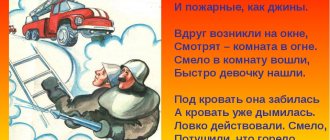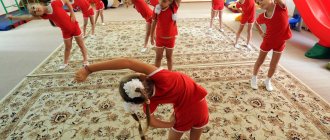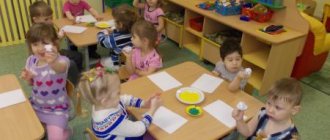Intellectual and educational game “Space Travel”
Intellectual and educational game for children and parents
“Space Travel”.
Target
: summarize and systematize children’s knowledge about space;
Tasks:
- consolidate children’s knowledge about the planets of the solar system, space technology;
-continue to teach how to work with algorithms and coding;
- cultivate a conscious, careful, emotional attitude towards the world around you;
-develop coherent speech, imagination, memory;
-develop figurative and spatial thinking;
— cultivate the ability to work in a team, empathize with each other, and the willingness to apply one’s knowledge.
-enrich parent-child relationships with the experience of joint activities;
-involve parents, through various types of activities, to participate in the educational process.
Preliminary work:
Search work to select illustrative material on the topic “Space”
.
Examination of albums, illustrations and photographs, a globe on the theme “Space”
.
Reading books and encyclopedias for preschoolers.
A selection of poems and riddles on the topic “Space”
.
Selection of didactic games in accordance with the topic.
Preparing a presentation “For children about space”
Equipment and materials:
Progress of the event:
Leading:
Hello guys and adults! I am glad that you responded to my proposal to spend this evening together with our large kindergarten family. I think you guessed what we will talk about today?! (answers) Of course, it is dedicated to Cosmonautics Day, the vast and unknown world of space.
And I want to suggest showing your knowledge in an intellectual game, where the children will “fight” with their parents. Where we find out which team is the most friendly, resourceful and smart.
I invite team members to take their places at the gaming tables.
And our work will be assessed by a strict but fair jury (present).
Well, as Yuri Alekseevich Gagarin said, “LET’S GO”
.
And our game will begin with a greeting from the teams, please, you have the floor.
Children's team:
team:
“Mars”
Our motto:
Mars is a mysterious planet. It is slightly smaller in size than the Moon. Because of its bright red color, the planet was named after the god of war.
Parents team:
team:
“Venus”
Our motto:
Venus is named after the goddess of beauty, you! You shine in the dark skies, You illuminate us with beauty.
Leading:
Applause to our participants.
1 TASK “RIDDLES”
Leading:
The first task of our game is riddles, which I will ask the teams in turn. The basic rule: listen to the riddle to the end, do not shout and choose the one who will give the answer. For each correct answer, the jury will award the team a star.
Card index of outdoor games on the topic "Space"
All the children scatter. Hands are raised up, joining in the center
fingers, as if depicting a rocket. Educator: - Rockets, get ready. Children
sit down. The teacher suggests saying the countdown together. All: - Five,
four, three, two, one, let's go! Children fly without bumping into each other.
Educator: - We've arrived. The children sat down.
7. "Day and Night"
First, you need to tell your child that the Earth on which we all live is spherical and spins. It’s great if there is a globe, then it will be very easy to show. If you don’t have such an object yet, you can take an ordinary spinning top, this will also not be difficult to clearly show how the planet rotates around its axis. You also need to take a flashlight for this game. By turning it on and turning the “ground”, the baby will see and understand that wherever the light of the flashlight does not fall, it becomes dark there and, accordingly, night falls.
2. "Cosmonauts"
Description: Children can play this game, dividing into subgroups, as in
indoors and outdoors. All over and
8. “Do it yourself solar system”
This is a creative game aimed at familiarizing the child with the entire solar system, with the planets and their location relative to the sun. You can make your own universe from materials that the child chooses. You can make a large applique, you can make planets from paper or plasticine. It is necessary to visually present the solar system to the child in the picture in the book, suggesting that the planets stick to the same coloring. The child can be asked to come up with his own planets, give them a name and populate them at his own discretion.
9. "Flight to the Moon"
This game is designed for a long time, because in order to fly to the moon you must first build a rocket. It all depends on the imagination of the players. There are often large cardboard boxes around the house. Such a body is perfect for constructing a means of transportation to the Moon. All children will enjoy designing a rocket, because you can come up with your own shape of the porthole and decorate it at your own discretion. You can plan a flight for a specific date by drawing up an action plan for getting ready for the trip. It will be mandatory to have a spacesuit on your head, because you can’t live on the Moon without it. While constructing, you can tell your child about gravity and the absence of air.
10. “Space stones”
Every kitchen has baking foil. Such material can quickly turn into stone balls. You can get a little creative and collect space stones that you can use to hit a target or just a bowl, training your accuracy.
We wish you good luck!
Publication address:
Space Games
Get ready! We're taking off! For a high-quality flight today, we don’t need complex equipment and masterpieces of modern aviation - just turn on games about space and go on an exciting journey!
Space games have prepared a lot of interesting things for their fans, because the Universe is much larger than one small Earth, which means there are a huge number of opportunities there. Is there anywhere else where you can fight aliens, play space sports games, drive high-speed shuttles and shoot with fantasy weapons? Space is huge. In its vastness, planets move, meteorites fly, asteroids drift. And all this is now available to players big and small who decided to walk through uncharted space and challenge the mysteries of the Universe.
All games in this genre involve flying. Therefore, before starting your adventure, you must check the comfort of your spacesuits, the amount of fuel in the engines, and the integrity of the vehicle shell. Everything is fine? Are you ready for adventure? Then go ahead! Flash space is already waiting for its pioneers and talented players.
Outdoor games for Cosmonautics Day
Outdoor games for Cosmonautics Day
"A space "
-
an outdoor
game for children 4 - 7 years old.
Description: All children can play this game, both indoors and outdoors. All the children scatter. The hands are raised up, connecting the fingers in the center, as if depicting a rocket. Educator: - Rockets, get ready. The children sat down. The teacher suggests saying the countdown together. All: - Five, four, three, two, one, let's go! Children fly without bumping into each other. Educator: - We've arrived. The children sat down.
"Martians"
- low
mobility game for children 4 - 7 years old
.
Description: All children can play this game, both indoors and outdoors. All children stand in a circle. With the help of a counter, the leader is selected. He gives cards
, face down.
They depict either people or “little green men” (Martians)
. The presenter closes his eyes and says the words:
Arrived _
I'm on the planet
Could this be a wonder of the world?
Well, maybe somewhere nearby?
It’s important for me to know everything in the world,
And unravel your secret.
At this time, children should look at the images of their cards.
. Their task is to show the presenter who they are - people or Martians, without uttering a word. The host comes up, clicks on the player and guesses. Then the host becomes the one who portrayed his role most interestingly.
«Astronauts»
-
an outdoor
game for children 4 - 7 years old.
Description: Children can play this game, dividing into subgroups, both indoors and outdoors. We lay out hoops throughout the playing space - these are “space suits”
.
There should be one less than participants. Cosmic music
plays , children run everywhere without stepping on hoops. The presenter says the words:
Friend, don’t yawn, but put on your spacesuit!
Players must stand in the hoop as quickly as possible and lift it up (as if putting on their spacesuit)
.
Anyone who did not have time to put on a spacesuit sits on a bench (remains on the ground)
.
The game continues, again with one less hoop. So, until there is only one winner left. This is who will be the first to fly into space
. The rest are not upset, next time they will definitely win too.
Flight
Participants are given the most ordinary plastic bags. They should be small in size and not too dense. At the leader's command, each participant tries to keep his bag in the air. To do this, he blows on it from bottom to top. The winner is the one who can carry out the longest flight of the package over the ground.
Gagarin
Participants of the competition stand in a circle and join hands, forming an orbit. In the center of the circle there is one - “Gagarin”. From time to time, players raise and lower their hands. The task of “Gagarin” is to break out of the circle within one minute, that is, “fly out of orbit.” The presenter records the time and monitors compliance with the rules of the competition.
Rocket
Competition for a young company. Participants are divided into teams. In each of them, a player is chosen to play the role of a “rocket”. The rest form two rows. Participants standing in opposite rows opposite each other join hands, forming a kind of “rocket” bed. The task of each team is to deliver its “rocket” to the finish line faster than the other.
Astrologer
Participants are located around the playing area in random order and crouch. They depict “stars,” but the “star” can only shine in a “standing” position. It is at this moment that the “stargazer” (driver), walking between the “stars,” must touch the player. If he managed to do this before the participant sat down again, then the “star” becomes a “stargazer”.
Bright constellations
For this competition you will need a constellation map (you can download it from the Internet and print it). Guests are divided into teams. The presenter shows by this constellation, for example, Orion, Ursa Major, Canis Major, Aquarius, and so on, and the teams answer in turn. The correct answer is one point per score, the wrong answer is zero. At the end of the game, each team's scores are tallied and the winner is determined.
Expedition to Mars
The presenter prepares in advance a long list of items that, in his opinion, must be taken with you on an expedition to Mars. He quickly reads it out loud to the players once, and then asks them to stand in a circle and take turns naming one item from the list. The one who names something that was not on the list, or repeats it, “flies to Earth” - sits on the floor. The one who remembers the most items from the list wins.
He is an astronaut and an astronaut in Africa
For this competition you will need helmets (boxing helmets, motorcycle helmets, racing helmets, whatever you can get), in extreme cases, the helmet can be replaced by wrapping several scarves around the participant’s head to make it look like a helmet. At the command “5, 4, 3, 2, 1, let’s go!” each participant begins to assemble a simple and small mosaic. Whoever is the first to correctly assemble the puzzle will receive the title of a real astronaut.
Baikonur
Each participant receives a sheet of paper and rolls a tube out of it, that is, creates his own rocket. Then they all stand along the same line and “launch” - they try to throw the tube rocket onto a cabinet or shelf. In this case, you cannot raise your hand above waist level. Those who succeed move on to the next round and receive a piece of paper half as large. The game continues until one winner is determined.
Training to become an astronaut
Participants are divided into pairs and show their astronaut training. The couple needs to pump up the press in half 100 times, that is, first one participant holds the legs of the other, and he pumps, and then vice versa. The pair that completes the task faster is ready to fly.




